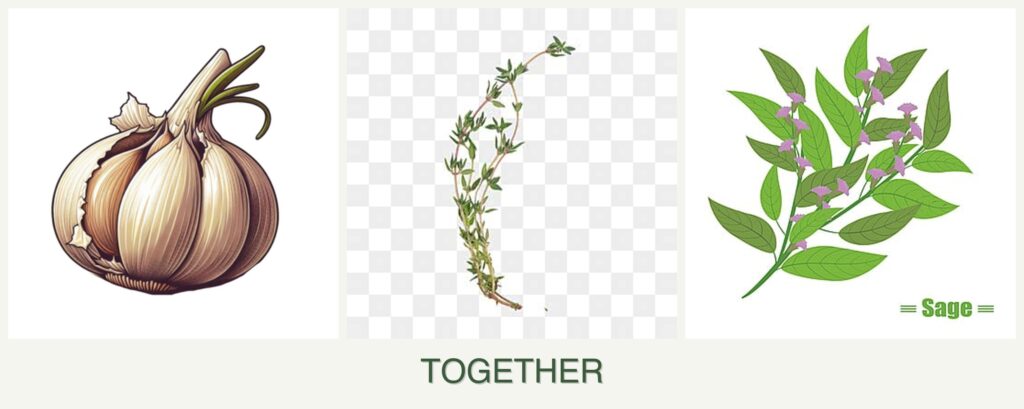
Can you plant garlic, thyme and sage together?
Can You Plant Garlic, Thyme, and Sage Together?
Companion planting is a popular gardening technique that involves growing different plants together to enhance growth, deter pests, and maximize garden space. Garlic, thyme, and sage are often considered for companion planting due to their complementary characteristics. In this article, we’ll explore whether these three can thrive together and offer practical tips for successful planting.
Compatibility Analysis
Yes, you can plant garlic, thyme, and sage together. These plants share several compatible traits that make them suitable companions. Garlic acts as a natural pest repellent, warding off insects that might otherwise target thyme and sage. All three plants prefer similar growing conditions, such as full sun and well-drained soil, making them compatible bedfellows in a vegetable or herb garden. Their nutrient needs and spacing requirements align well, reducing competition for resources.
Key Factors
- Growth Requirements: All three plants thrive in full sun and require well-drained soil.
- Pest Control: Garlic’s pungent aroma deters many common garden pests, providing natural protection.
- Nutrient Needs: They have similar nutrient requirements, which simplifies feeding schedules.
- Spacing: Proper spacing ensures each plant has enough room to grow without overshadowing others.
Growing Requirements Comparison Table
| Plant | Sunlight Needs | Water Requirements | Soil pH | Hardiness Zones | Spacing | Growth Habit |
|---|---|---|---|---|---|---|
| Garlic | Full sun | Moderate | 6.0-7.0 | 3-8 | 4-6 inches | Upright, bulbous |
| Thyme | Full sun | Low to moderate | 6.0-8.0 | 5-9 | 12 inches | Low, spreading |
| Sage | Full sun | Low to moderate | 6.0-7.0 | 4-8 | 12-18 inches | Bushy, upright |
Benefits of Planting Together
Planting garlic, thyme, and sage together offers several benefits:
- Pest Repellent Properties: Garlic’s sulfur compounds help deter pests, protecting thyme and sage.
- Improved Flavor and Growth: The aromatic nature of thyme and sage can enhance the flavor of garlic, and vice versa.
- Space Efficiency: These herbs have compact growth habits, allowing for efficient use of garden space.
- Soil Health Benefits: Garlic can improve soil structure and health over time.
- Pollinator Attraction: Thyme and sage flowers attract beneficial pollinators, enhancing garden biodiversity.
Potential Challenges
While these plants are compatible, there are potential challenges to consider:
- Competition for Resources: Ensure adequate spacing to prevent competition for sunlight and nutrients.
- Watering Needs: Garlic requires more consistent moisture during its growing season, while thyme and sage prefer drier conditions.
- Disease Susceptibility: Monitor for fungal diseases, especially in humid climates.
- Harvesting Considerations: Garlic’s harvest time may differ from thyme and sage, requiring careful planning.
Practical Solutions
- Use mulch to retain moisture for garlic while preventing overwatering of thyme and sage.
- Rotate crops annually to prevent soil-borne diseases.
- Consider raised beds to improve drainage and prevent waterlogging.
Planting Tips & Best Practices
- Optimal Spacing: Plant garlic 4-6 inches apart, thyme 12 inches apart, and sage 12-18 inches apart.
- Timing: Plant garlic in the fall, while thyme and sage can be planted in spring after the last frost.
- Container vs. Garden Bed: All three can be grown in garden beds or containers, but ensure containers have drainage holes.
- Soil Preparation: Amend soil with compost to improve fertility and drainage.
- Companion Plants: Consider adding rosemary or lavender, which also pair well with garlic, thyme, and sage.
FAQ Section
-
Can you plant garlic and thyme in the same pot?
- Yes, but ensure the pot is large enough and has good drainage.
-
How far apart should garlic, thyme, and sage be planted?
- Garlic: 4-6 inches; Thyme: 12 inches; Sage: 12-18 inches.
-
Do garlic, thyme, and sage need the same amount of water?
- Garlic needs more consistent moisture, while thyme and sage prefer drier conditions.
-
What should not be planted with garlic, thyme, and sage?
- Avoid planting garlic with legumes, and keep thyme and sage away from overly water-dependent plants.
-
Will garlic affect the taste of thyme and sage?
- Garlic can enhance the flavor of nearby herbs without negatively affecting their taste.
-
When is the best time to plant garlic, thyme, and sage together?
- Plant garlic in the fall and thyme and sage in the spring for optimal growth.
By understanding these plants’ compatibility and following best practices, you can create a thriving herb garden that maximizes the benefits of companion planting.



Leave a Reply